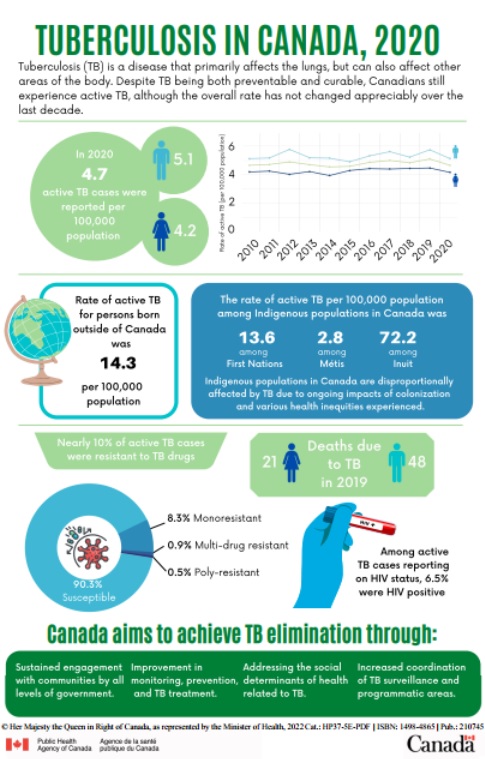Tuberculosis in Canada, 2020
Tuberculosis (TB) is a disease that primarily affects the lungs, but can also affect other areas of the body. Despite TB being both preventable and curable, Canadians still experience active TB, although the overall rate has not changed appreciably over the last decade.
In 2020, 4.7 active TB cases were reported per 100,000 population. The corresponding rate for females was 4.2 cases per 100,000 populations, compared to 5.1 cases per 100,000 population for men. These rates for the 2010 - 2020 period are detailed in the following table:
| Year | 2010 | 2011 | 2012 | 2013 | 2014 | 2015 | 2016 | 2017 | 2018 | 2019 | 2020 |
|---|---|---|---|---|---|---|---|---|---|---|---|
Male |
5.1 | 5.2 | 5.8 | 5.2 | 5.2 | 4.9 | 5.3 | 5.6 | 5.2 | 5.7 | 5.1 |
Female |
4.2 | 4.3 | 4 | 4.2 | 4 | 4.3 | 4.4 | 4.4 | 4.4 | 4.5 | 4.2 |
Overall |
4.7 | 4.7 | 4.9 | 4.7 | 4.6 | 4.6 | 4.9 | 5 | 4.8 | 5.1 | 4.7 |
The rate of active TB for persons born outside of Canada was 14.3 per 100,000 population.
The rate of active TB per 100,000 population among Indigenous populations in Canada was:
- 13.6 among First Nations with Status
- 2.8 among Métis
- 72.2 among Inuit
Indigenous populations in Canada are disproportionally affected by TB due to ongoing impacts of colonization and various health inequities experienced.
Nearly 10% of active TB cases were resistant to TB drugs:
- 8.3% were monoresistant
- 0.9% were multi-drug resistant
- 0.5% were poly-resistant
Of the deaths due to TB in 2020, 21 were female and 48 were male.
Among active TB cases reporting on HIV status, 6.5% were HIV positive.
Canada aims to achieve TB elimination through:
- Sustained engagement with communities by all levels of government
- Improvement in monitoring, prevention, and TB treatment
- Addressing the social determinants of health related to TB
- Increased coordination of TB surveillance and programmatic areas
